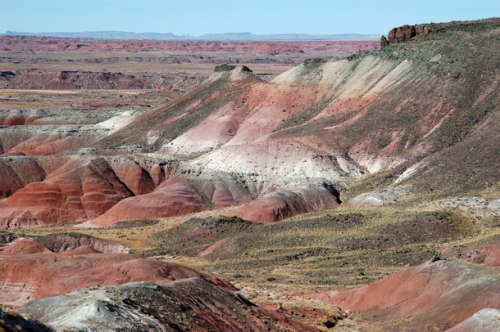
Photo: Woody Hibbard, Flickr
Petrified Forest National Park reaches into the Painted Desert in Arizona, which boasts a colorful badlands ecosystem.
A former colleague of mine, a naturalized citizen originally from northern China, has a goal to visit all the national parks. He puts me to shame. I have visited so few. But after listening to this story from the environmental radio show Living on Earth, I know I would really like to see one national park — Arizona’s Petrified Forest.
“BOBBY BASCOMB: We continue our series on US public lands now with a trip to one of our more unusual National Parks. Arizona’s Petrified Forest National Park is full of wildlife, and the beautiful hiking trails that we’ve come to expect in our public lands.
“But what really sets it apart are the trees that died there. … The fossilized remains of those trees, logs more than 6 feet in diameter, are still there today, cast in stone. Here to explain more about the unique geological process that preserved the ancient trees is Sarah Herve, the acting chief of interpretation for the park. …
“SARAH HERVE: Petrified wood is a fossil. A lot of times people think that it’s something different than you know, any other kind of fossil … the remains of gigantic forests that were here during the Late Triassic. The logs … have been turned to stone by rapid burial.
“There’s silica in the materials that the trees were buried in and the cellular structure has been replaced by silica. There’s other minerals present, but the glassy mineral silica is really, really good at exchanging places with cellular material. …
“BASCOMB: The end result then, is you have these logs lying around that look exactly like trees, you can see the rings in them, the bark, the whole thing, but it’s stone. …
“HERVE: That wood is oftentimes what we call rainbow wood, because it’s very, very colorful. [When] you look on the inside, there’s all kinds of pinks and purples and blue colors, blacks, and it’s really just amazing. … If you can picture these logs when they were trees, they would be comparable to like the giant sequoias of California. …
“BASCOMB: What are scientists able to learn about the geology of the area and the trees themselves from studying this petrified wood? …
“HERVE: This part of northern Arizona was a much more tropical kind of environment. We were closer to the equator at that time, the continents were together to form Pangaea, there was quite a bit more water through this region. [That’s] based on looking at the different fossils that are found within these rocks and the rocks themselves. It’s thought that there was a tremendous river system that was running through this area. … Something on the same magnitude as like the Mississippi or the Amazon River. …
“It’s really hard to imagine [a] place so full of trees and crocodile-like animals running around and lots of amphibians, right. Those are some of the different fossils that we find. … Then we have, you know, incredible badland topography. So that’s what a lot of people, you know, call the Painted Desert. And it is very, very colorful, that’s why it gets that name. But those deposits are the remains of those ancient rivers. … The dinosaurs that we find at Petrified Forest, they’re generally pretty small. So we’re at a time way before all the big dinosaurs happened. …
“BASCOMB: I understand that you also have petroglyphs there, left over from early inhabitants of the area. …
“HERVE: There’s a lot of petroglyphs or what we call rock art in the park. There’s [sometimes] animistic forms. So you’ll see things that look like different kinds of birds or things that look really obviously like deer, you know, or elk or pronghorn antelope, which are animals that still live in the park today. And then some of the forms are very, very strange, and really hard to interpret. Some of the petroglyphs are also considered what we call solstice markers, or solar calendars. And so they have light interactions with the sun during different times of the year. …
“BASCOMB: We have a lot of national parks in our country; we’re very lucky that way. Why should somebody visit this park as opposed to any other?
“HERVE: You know, what I hear from a lot of park visitors is, ‘Wow, we’re so glad we came here, we like this better than Grand Canyon!’ And that’s not a dig on Grand Canyon. But it’s always interesting to me to hear that because I think a lot of times people don’t realize right when they get off the interstate what they’re in for.”
More at Living on Earth, here.
Thinking about my friend who is visiting all the parks, I realize it’s not unusual for naturalized citizens to appreciate the wonder and variety of this great land more than some of us who are native born. Another former colleague, also originally from China, has been expressing his delight in America by running half-marathons around the country. He has already covered more than half the states and won’t stop until he has run in all 50.

I do think you’re right, that we take our fine country for granted. I’m always thinking about big, fancy trips abroad . . . when I haven’t been much of anywhere here at home!
It’s never too late. I hope.
Wowsah! Those petrified trees do sound as though they are worth seeing.
At least one doesn’t have to add “while they last”!
Right!
Born in the USA, I have visited many national parks (and, unfortunately, only a few other countries.) These parks are extraordinary natural treasures that will always need protection from those who see them merely as sources of various commodities. Visit and be enchanted!
You are so right. Thank you.